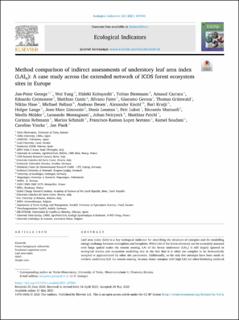| dc.contributor.author | George, Jan-Peter | |
| dc.contributor.author | Yang, Wei | |
| dc.contributor.author | Kobayashi, Hideki | |
| dc.contributor.author | Biermann, Tobias | |
| dc.contributor.author | Carrara, Arnaud | |
| dc.contributor.author | Cremonese, Edoardo | |
| dc.contributor.author | Cuntz, Matthias | |
| dc.contributor.author | Fares, Silvano | |
| dc.contributor.author | Gerosa, Giacomo | |
| dc.contributor.author | Grünwald, Thomas | |
| dc.contributor.author | Hase, Niklas | |
| dc.contributor.author | Heliasz, Michael | |
| dc.contributor.author | Ibrom, Andreas | |
| dc.contributor.author | Knohl, Alexander | |
| dc.contributor.author | Kruijt, Bart | |
| dc.contributor.author | Lange, Holger | |
| dc.contributor.author | Limousin, Jean-Marc | |
| dc.contributor.author | Loustau, Denis | |
| dc.contributor.author | Lukeš, Petr | |
| dc.contributor.author | Marzuoli, Riccardo | |
| dc.contributor.author | Mölder, Meelis | |
| dc.contributor.author | Montagnani, Leonardo | |
| dc.contributor.author | Neirynck, Johan | |
| dc.contributor.author | Peichl, Matthias | |
| dc.contributor.author | Rebmann, Corinna | |
| dc.contributor.author | Schmidt, Marius | |
| dc.contributor.author | Serrano, Francisco Ramon Lopez | |
| dc.contributor.author | Soudani, Kamel | |
| dc.contributor.author | Vincke, Caroline | |
| dc.contributor.author | Pisek, Jan | |
| dc.date.accessioned | 2021-12-02T09:21:40Z | |
| dc.date.available | 2021-12-02T09:21:40Z | |
| dc.date.created | 2021-06-03T08:32:59Z | |
| dc.date.issued | 2021-05-31 | |
| dc.identifier.citation | Ecological Indicators. 2021, 128 . | en_US |
| dc.identifier.issn | 1470-160X | |
| dc.identifier.uri | https://hdl.handle.net/11250/2832503 | |
| dc.description.abstract | Leaf area index (LAI) is a key ecological indicator for describing the structure of canopies and for modelling energy exchange between atmosphere and biosphere. While LAI of the forest overstory can be accurately assessed over large spatial scales via remote sensing, LAI of the forest understory (LAIu) is still largely ignored in ecological studies and ecosystem modelling due to the fact that it is often too complex to be destructively sampled or approximated by other site parameters. Additionally, so far only few attempts have been made to retrieve understory LAI via remote sensing, because dense canopies with high LAI are often hindering retrieval algorithms to produce meaningful estimates for understory LAI. Consequently, the forest understory still constitutes a poorly investigated research realm impeding ecological studies to properly account for its contribution to the energy absorption capacity of forest stands. This study aims to compare three conceptually different indirect retrieval methodologies for LAIu over a diverse panel of forest understory types distributed across Europe. For this we carried out near-to-surface measurements of understory reflectance spectra as well as digital surface photography over the extended network of Integrated Carbon Observation System (ICOS) forest ecosystem sites. LAIu was assessed by exploiting the empirical relationship between vegetation cover and light absorption (Beer-Lambert- Bouguer law) as well as by utilizing proposed relationships with two prominent vegetation indices: normalized difference vegetation index (NDVI) and simple ratio (SR). Retrievals from the three methods were significantly correlated with each other (r = 0.63–0.99, RMSE = 0.53–0.72), but exhibited also significant bias depending on the LAI scale. The NDVI based retrieval approach most likely overestimates LAI at productive sites when LAIu > 2, while the simple ratio algorithm overestimates LAIu at sites with sparse understory vegetation and presence of litter or bare soil. The purely empirical method based on the Beer-Lambert law of light absorption seems to offer a good compromise, since it provides reasonable LAIu values at both low and higher LAI ranges. Surprisingly, LAIu variation among sites seems to be largely decoupled from differences in climate and light permeability of the overstory, but significantly increased with vegetation diversity (expressed as species richness) and hence proposes new applications of LAIu in ecological modelling. | en_US |
| dc.language.iso | eng | en_US |
| dc.publisher | Elsevier Ltd. | en_US |
| dc.rights | Navngivelse 4.0 Internasjonal | * |
| dc.rights.uri | http://creativecommons.org/licenses/by/4.0/deed.no | * |
| dc.subject | Jordobservasjon fra satellitter | en_US |
| dc.subject | Earth-monitoring satellites | en_US |
| dc.subject | Fjernmåling | en_US |
| dc.subject | Remote sensing | en_US |
| dc.title | Method comparison of indirect assessments of understory leaf area index (LAIu): A case study across the extended network of ICOS forest ecosystem sites in Europe | en_US |
| dc.type | Peer reviewed | en_US |
| dc.type | Journal article | en_US |
| dc.description.version | publishedVersion | en_US |
| dc.rights.holder | © 2021 The Authors | en_US |
| dc.source.pagenumber | 11 | en_US |
| dc.source.volume | 128 | en_US |
| dc.source.journal | Ecological Indicators | en_US |
| dc.identifier.doi | 10.1016/j.ecolind.2021.107841 | |
| dc.identifier.cristin | 1913444 | |
| dc.relation.project | Norges forskningsråd: 245927 | en_US |
| dc.relation.project | EC/H2020/654359 | en_US |
| dc.relation.project | Norges forskningsråd: 255061 | en_US |
| dc.source.articlenumber | 107841 | en_US |
| cristin.ispublished | true | |
| cristin.fulltext | original | |
| cristin.qualitycode | 1 | |

